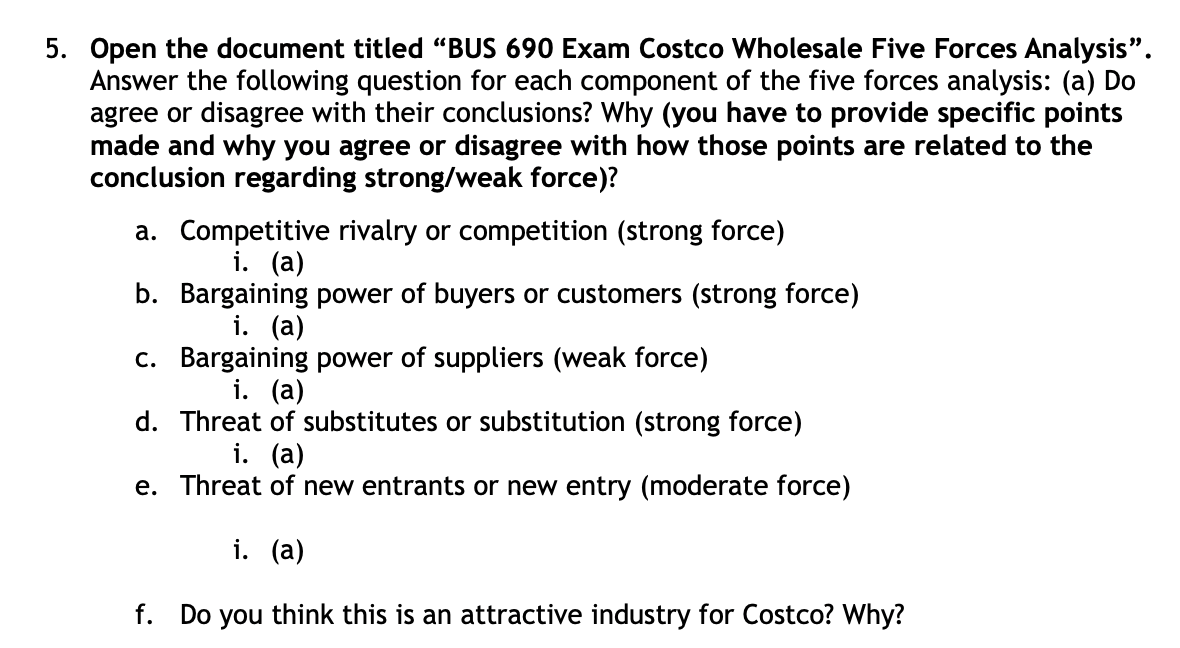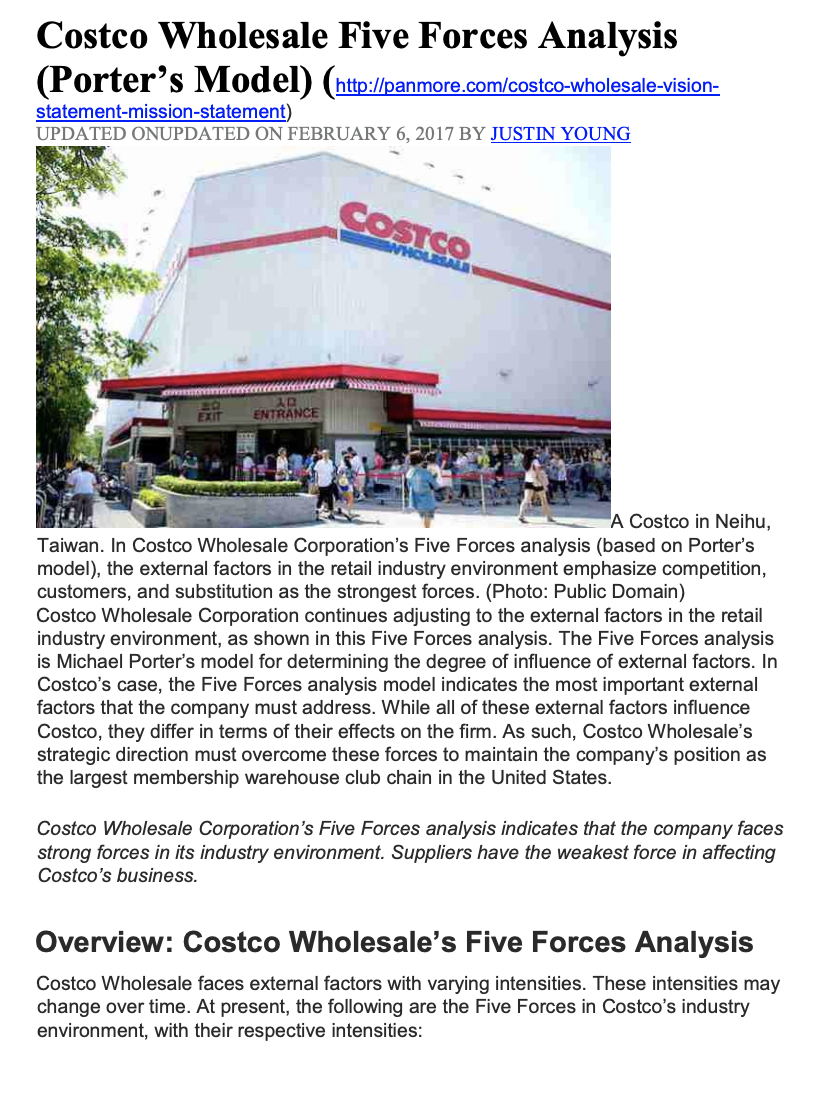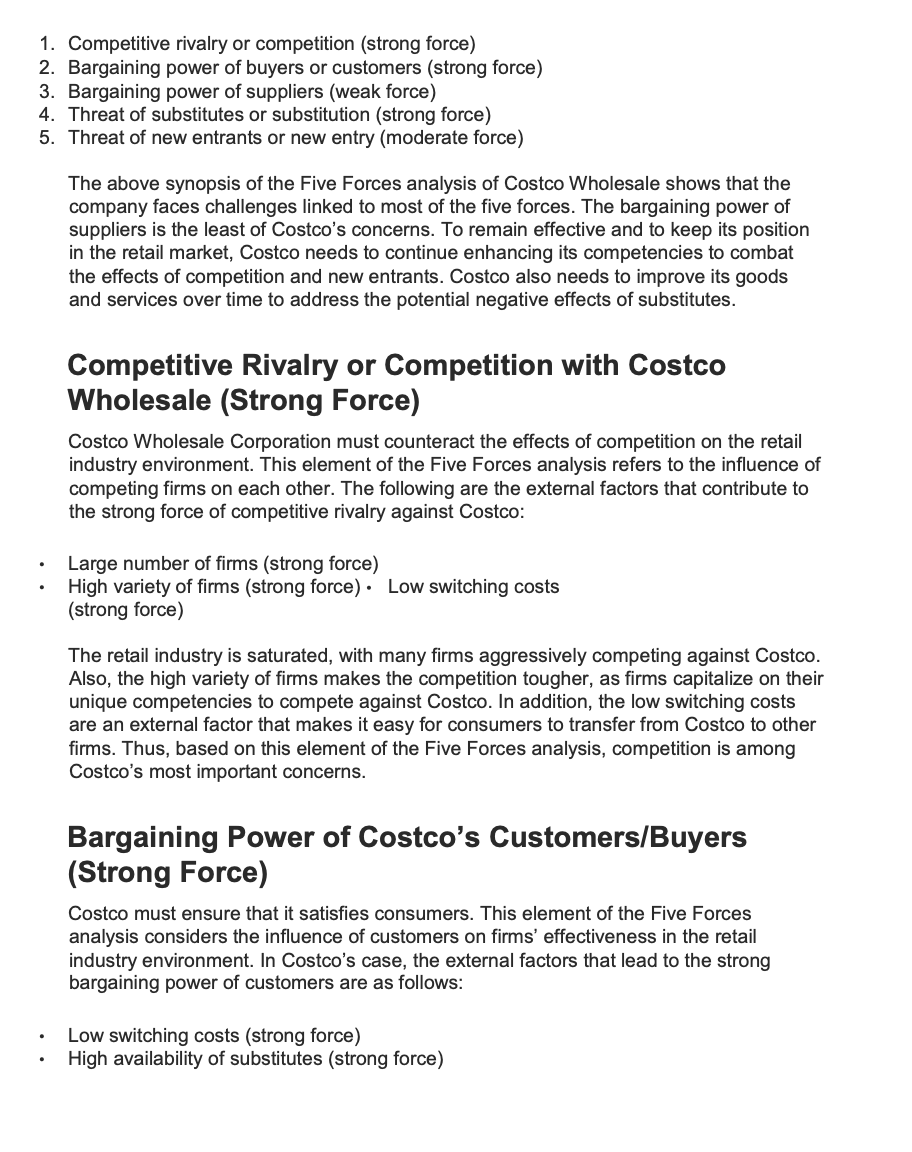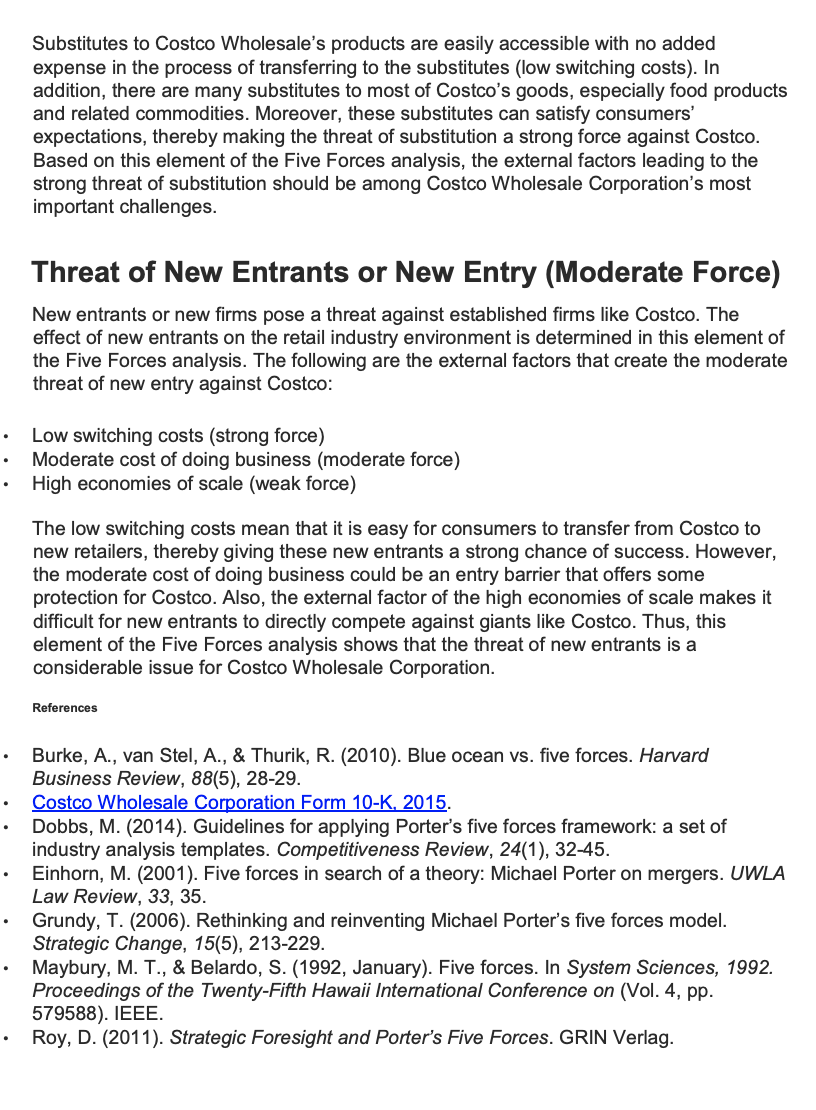




Open the document titled "BUS 690 Exam Costco Wholesale Five Forces Analysis". Answer the following question for each component of the five forces analysis: (a) Do agree or disagree with their conclusions? Why (you have to provide specific points made and why you agree or disagree with how those points are related to the conclusion regarding strong/weak force)? a. Competitive rivalry or competition (strong force) i. (a) b. Bargaining power of buyers or customers (strong force) i. (a) c. Bargaining power of suppliers (weak force) i. (a) d. Threat of substitutes or substitution (strong force) i. (a) e. Threat of new entrants or new entry (moderate force) i. (a) f. Do you think this is an attractive industry for Costco? Why? Costco Wholesale Five Forces Analysis (Porter's Model) (htto:llpanmore.comlcostco-wholesale-visionstatement-mission-statement) stco in Neihu, Taiwan. In Costco Wholesale Corporation's Five Forces analysis (based on Porter's model), the external factors in the retail industry environment emphasize competition, customers, and substitution as the strongest forces. (Photo: Public Domain) Costco Wholesale Corporation continues adjusting to the external factors in the retail industry environment, as shown in this Five Forces analysis. The Five Forces analysis is Michael Porter's model for determining the degree of influence of external factors. In Costco's case, the Five Forces analysis model indicates the most important external factors that the company must address. While all of these external factors influence Costco, they differ in terms of their effects on the firm. As such, Costco Wholesale's strategic direction must overcome these forces to maintain the company's position as the largest membership warehouse club chain in the United States. Costco Wholesale Corporation's Five Forces analysis indicates that the company faces strong forces in its industry environment. Suppliers have the weakest force in affecting Costco's business. Overview: Costco Wholesale's Five Forces Analysis Costco Wholesale faces external factors with varying intensities. These intensities may change over time. At present, the following are the Five Forces in Costco's industry environment, with their respective intensities: 2. Bargaining power of buyers or customers (strong force) 3. Bargaining power of suppliers (weak force) 4. Threat of substitutes or substitution (strong force) 5. Threat of new entrants or new entry (moderate force) The above synopsis of the Five Forces analysis of Costco Wholesale shows that the company faces challenges linked to most of the five forces. The bargaining power of suppliers is the least of Costco's concerns. To remain effective and to keep its position in the retail market, Costco needs to continue enhancing its competencies to combat the effects of competition and new entrants. Costco also needs to improve its goods and services over time to address the potential negative effects of substitutes. Competitive Rivalry or Competition with Costco Wholesale (Strong Force) Costco Wholesale Corporation must counteract the effects of competition on the retail industry environment. This element of the Five Forces analysis refers to the influence of competing firms on each other. The following are the external factors that contribute to the strong force of competitive rivalry against Costco: Large number of firms (strong force) High variety of firms (strong force) - Low switching costs (strong force) The retail industry is saturated, with many firms aggressively competing against Costco. Also, the high variety of firms makes the competition tougher, as firms capitalize on their unique competencies to compete against Costco. In addition, the low switching costs are an external factor that makes it easy for consumers to transfer from Costco to other firms. Thus, based on this element of the Five Forces analysis, competition is among Costco's most important concerns. Bargaining Power of Costco's Customers/Buyers (Strong Force) Costco must ensure that it satisfies consumers. This element of the Five Forces analysis considers the influence of customers on firms' effectiveness in the retail industry environment. In Costco's case, the external factors that lead to the strong bargaining power of customers are as follows: Low switching costs (strong force) High availability of substitutes (strong force) High quality of information (strong force) The low switching costs mean that Costco's customers can easily transfer to other retailers like Walmart's Sam's Club. In relation, Costco consumers have many substitutes to choose from. Also, because of the Internet, Costco's customers can easily access information about prices and offers among competing retailers. As a result, it becomes even easier for them to transfer to the retailers that have best offers. These external factors indicate that Costco Wholesale Corporation must consider the bargaining power of buyers as among the top issues in this Five Forces analysis. Bargaining Power of Costco Wholesale's Suppliers (Weak Force) Suppliers affect Costco's business and the retail industry environment. The demands and impact of suppliers on businesses are covered in this element of the Five Forces analysis. The following are the external factors that create the weak bargaining power of suppliers in Costco's case: Large population of suppliers (weak force) High overall supply (weak force) Low forward integration (weak force) Because of the large population of suppliers, no single supplier can easily impose its demands on firms like Costco. Suppliers' bargaining power is further weakened because the overall supply is high, which means that a single supplier's action is unlikely to significantly impact the level of total supply available to Costco. In addition, most of Costco's suppliers have low forward integration, which means that they have minimal control on the distribution and sale of their products in Costco warehouses/stores. This element of the Five Forces analysis shows that the external factors leading to the bargaining power of suppliers are among the least of Costco's concerns. Threat of Substitutes or Substitution (Strong Force) Substitution is a challenge to Costco. In this element of the Five Forces analysis, substitutes' influences on firms and the retail industry environment are addressed. In Costco's case, the external factors that contribute to the strong threat of substitution are as follows: Low switching costs (strong force) - High availability of substitutes (strong force) - High performance-to-price ratio of substitutes (strong force) Substitutes to Costco Wholesale's products are easily accessible with no added expense in the process of transferring to the substitutes (low switching costs). In addition, there are many substitutes to most of Costco's goods, especially food products and related commodities. Moreover, these substitutes can satisfy consumers' expectations, thereby making the threat of substitution a strong force against Costco. Based on this element of the Five Forces analysis, the external factors leading to the strong threat of substitution should be among Costco Wholesale Corporation's most important challenges. Threat of New Entrants or New Entry (Moderate Force) New entrants or new firms pose a threat against established firms like Costco. The effect of new entrants on the retail industry environment is determined in this element of the Five Forces analysis. The following are the external factors that create the moderate threat of new entry against Costco: Low switching costs (strong force) Moderate cost of doing business (moderate force) High economies of scale (weak force) The low switching costs mean that it is easy for consumers to transfer from Costco to new retailers, thereby giving these new entrants a strong chance of success. However, the moderate cost of doing business could be an entry barrier that offers some protection for Costco. Also, the external factor of the high economies of scale makes it difficult for new entrants to directly compete against giants like Costco. Thus, this element of the Five Forces analysis shows that the threat of new entrants is a considerable issue for Costco Wholesale Corporation. References Burke, A., van Stel, A., \& Thurik, R. (2010). Blue ocean vs. five forces. Harvard Business Review, 88(5), 28-29. Costco Wholesale Corporation Form 10-K, 2015. Dobbs, M. (2014). Guidelines for applying Porter's five forces framework: a set of industry analysis templates. Competitiveness Review, 24(1), 32-45. Einhorn, M. (2001). Five forces in search of a theory: Michael Porter on mergers. UWLA Law Review, 33, 35. Grundy, T. (2006). Rethinking and reinventing Michael Porter's five forces model. Strategic Change, 15(5), 213-229. Maybury, M. T., \& Belardo, S. (1992, January). Five forces. In System Sciences, 1992. Proceedings of the Twenty-Fifth Hawaii International Conference on (Vol. 4, pp. 579588). IEEE. Roy, D. (2011). Strategic Foresight and Porter's Five Forces. GRIN Verlag











